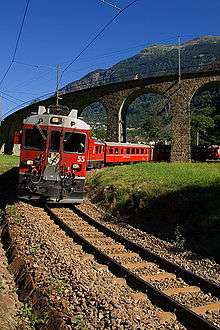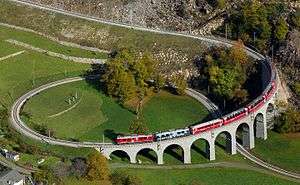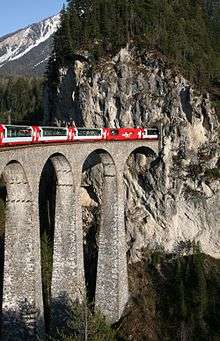Brusio spiral viaduct
| Brusio spiral viaduct Viadotto elicoidale di Brusio | |
|---|---|
|
The Bernina Express on the viaduct | |
| Coordinates | 46°15′14″N 10°07′40″E / 46.25389°N 10.12778°ECoordinates: 46°15′14″N 10°07′40″E / 46.25389°N 10.12778°E |
| Carries | Rhaetian Railway |
| Locale | Brusio, Switzerland |
| Official name | Viadotto elicoidale di Brusio |
| Other name(s) | Kreisviadukt Brusio |
| Owner | Rhaetian Railway |
| Maintained by | Rhaetian Railway |
| Characteristics | |
| Design | Spiral arch bridge, viaduct |
| Material | Stone |
| Total length | 110 m (360 ft) |
| Number of spans | 9, each of 10 m (33 ft) |
The Brusio spiral viaduct (or Brusio circular viaduct; Italian: Viadotto elicoidale di Brusio, German: Kreisviadukt Brusio) is a single-track nine-arched stone spiral railway viaduct.
A signature structure of the World Heritage-listed Bernina railway, it is located near Brusio, in the Canton of Graubünden, Switzerland, and was built to limit the railway's gradient at that location within its specified maximum of 7%.[1]
Location
The Brusio spiral viaduct forms part of the Bernina Railway section between Brusio and Campascio. It is just south of Brusio, and approximately 54 kilometres (34 mi) from St. Moritz.[2]
History

The viaduct was opened on 1 July 1908, upon the opening of the Tirano–Poschiavo section of the Bernina Railway.[3]
A spiral viaduct was required immediately south of Brusio to limit the railway's grade to the required maximum of 7%, so the train would not slip on the way up, or be uncontrollable on the way down. Geological factors prevented the boring of the spiral tunnel that had originally been planned. Engineers therefore decided to construct on the valley floor a 360 degree curve with a 50 to 70 m (160 to 230 ft) radius, and the viaduct forms part of that curve.[1]
In 1943, the whole of the Bernina Railway was taken over by the Rhaetian Railway, which still owns and uses the spiral viaduct today.
Technical data
The spiral viaduct is 110 metres (360 ft) long, has a horizontal radius of curvature of 70 metres (230 ft), a longitudinal slope of 7%, and is made up of nine spans, each 10 metres (33 ft) in length.
See also
References
Notes
- 1 2 Moser & Pfeiffer 2004, p. 51.
- ↑ Moser & Pfeiffer 2004, pp. 50–51.
- ↑ Moser & Pfeiffer 2004, p. 50.
Bibliography
- Belloncle, Patrick, Le chemin de fer Rhétique, 1889-1999, Les Editions du Cabri, Switzerland, ISBN 2-908816-45-8 (French)
- Moser, Beat; Pfeiffer, Peter (2004). Die RhB. Teil 2: Berninabahn • St. Moritz – Tirano [The RhB. Part 2: Berninabahn • St. Moritz – Tirano]. Eisenbahn Journal Special-Ausgabe 2/2004. Fürstenfeldbruck: Eisenbahn Journal. ISBN 3896101285. (German)
- Widmer, Markus, Eisenbahnbrücken, transpress, Stuttgart (Germany), ISBN 3-344-71019-2 (German)
External links
| Wikimedia Commons has media related to Brusio spiral bridge. |
- "Kreisviadukt Brusio". brueckenweb.de (in German).
- Brusio Circular Viaduct at Structurae
- Webcam overlooking Brusio spiral viaduct (Italian)

